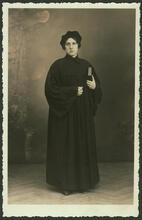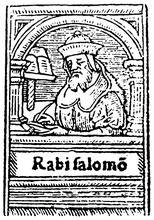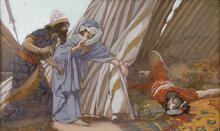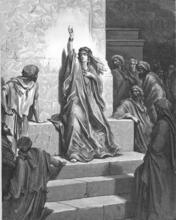Beruryah
Beruryah is the only woman in rabbinic literature who studies Torah. Identified as the daughter of Rabbi Hananiah b. Teradyon and the wife of Rabbi Meir, she delivers halakhic and homiletical statements in the Tosefta and Babylonian Talmud and is described as a prodigious learner. Later medieval traditions neutralized Beruryah, giving her a tragic death after she mocked a rabbinic dictum about women’s lightheadedness.
Depiction and History
Beruryah is the only woman Torah she-bi-khetav: Lit. "the written Torah." The Bible; the Pentateuch; Tanakh (the Pentateuch, Prophets and Hagiographia)Torah scholar mentioned in rabbinic literature. She is traditionally depicted as the daughter of Rabbi Hananiah ben Teradyon and the wife of Rabbi Meir, although there is room for doubt about these biographical details.
Beruryah is mentioned by name four times in the The discussions and elaborations by the amora'im of Babylon on the Mishnah between early 3rd and late 5th c. C.E.; it is the foundation of Jewish Law and has halakhic supremacy over the Jerusalem Talmud.Babylonian Talmud, with relation to six separate incidents (BT Berakhot 10a; BT A seven-day festival to commemorate the Exodus from Egypt (eight days outside Israel) beginning on the 15th day of the Hebrew month of Nissan. Also called the "Festival of Mazzot"; the "Festival of Spring"; Pesah.Pesahim 62b; BT Eruvin 53b–54a; BT Avodah Zarah 18b). She is also mentioned by name once in the earlier Lit. (from Aramaic teni) "to hand down orally," "study," "teach." A scholar quoted in the Mishnah or of the Mishnaic era, i.e., during the first two centuries of the Common Era. In the chain of tradition, they were followed by the amora'im.tannaitic stratum of rabbinic literature, in a composition known as the (Aramaic) A work containing a collection of tanna'itic beraitot, organized into a series of tractates each of which parallels a tractate of the Mishnah.Tosefta
(Kelim Bava Mezia 1:6). Two further incidents recorded in tannaitic literature (one in Tosefta Kelim Bava Kamma 4:17 and one in Sifre Deuteronomy 307) mentioning the (unnamed) daughter of Rabbi Hananiah ben Teradyon are traditionally also associated with Beruryah. So too are two traditions in later midrashim, one in the post-talmudic Tractate Semahot (12:13), which mentions the daughter of Rabbi Hananiah ben Teradyon and another in the A type of non-halakhic literary activitiy of the Rabbis for interpreting non-legal material according to special principles of interpretation (hermeneutical rules).Midrash on Proverbs (31:10) referring to the (unnamed) wife of Rabbi Meir. However, there is room for doubt about these associations.
“Beruryah Spoke Well”
In the earliest mention of Beruryah she is cited simply as making a The legal corpus of Jewish laws and observances as prescribed in the Torah and interpreted by rabbinic authorities, beginning with those of the Mishnah and Talmud.halakhic decision concerning an object referred to by the (Greek) word klaustra. This decision is not halakhically significant and it is important only because it is the only tradition in the halakhic corpus that is transmitted by a named woman. Having uttered this decision, she is then praised by Rabbi Joshua ben Hananiah. This suggests that the Tosefta here preserved some dim memory of a woman who may once have studied with the rabbis and left an impression on them. More than this is historically impossible to conclude about her. Beruryah’s decision is also cited in the Codification of basic Jewish Oral Law; edited and arranged by R. Judah ha-Nasi c. 200 C.E.Mishnah, but Beruryah herself has meanwhile disappeared and the tradition is now assigned to Rabbi Joshua himself (Mishnah Kelim 11:4). This seems to be the reaction of the mishnaic editors to the presence of a woman in the rabbinic academy.
However, if Rabbi Joshua is a contemporary of the scholar Beruryah, it is unlikely that she was the daughter of Rabbi Hananiah ben Teradyon, who was a generation younger than Rabbi Joshua, or the wife of Rabbi Meir, who was two generations younger. It seems that Beruryah’s pedigree was an invention of the Babylonian Talmud, based on another tradition found in the Tosefta, in which the (unnamed) daughter of Rabbi Hananiah ben Teradyon is also cited making a halakhic decision (Tosefta Kelim Bava Kamma 4:17). In two locations in the Babylonian Talmud Beruryah is specifically described as the daughter of Rabbi Hananiah ben Teradyon and the wife of Rabbi Meir (BT Pesahim 62b; BT Avodah Zarah 18b).
Beruryah in the Babylonian Talmud
Unlike the Mishnah, which edited Beruryah out, the Babylonian Talmud must have been impressed by her recorded halakhic decision, for it proclaimed her a great sage who had learnt “three hundred traditions from three hundred masters in one day” (BT Pesahim 62b). She is further described as instructing her husband, Rabbi Meir, about how to interpret a biblical verse; a heretic about the meaning of a verse in Isaiah (BT Berakhot 10a); Rabbi Yose ha-Gelili (beginning of the second century c.e.) about how to understand the maxim from Tractate Avot “Speak not much with a woman”; and a student about how not to learn Torah in silence (BT Eruvin 53b–54a). All these make the Babylonian Beruryah a great scholar. The two significant innovations we find concerning Beruryah in the Babylonian Talmud (her great scholarship and her family relations) are there to answer the question that puzzled the Babylonians, namely, how could a woman become a scholar and be recorded in the sources as such. Their answer is that she must have been extremely clever, but also that she must have had a supportive family whose members were themselves sages.
Beruryah’s Sister and Her Fate
Beruryah’s final appearance in the Babylonian Talmud is associated with the aftermath of the Bar Kokhba Rebellion and the decrees instigated by the Romans against the Jewish religion. In a tannaitic source we learn that Rabbi Hananiah ben Teradyon was sentenced to be burnt and his daughter to “do work” (whatever that may mean—Sifre Deuteronomy 307). In the Babylonian Talmud this “doing work” is now interpreted as being sent to a brothel (BT Avodah Zarah 18b). However, from the way the story in the Babylonian Talmud is related it becomes clear that it was not Beruryah, but another daughter of the sage who suffered this fate. The story continues with Beruryah sending Rabbi Meir to rescue her sister. Although the rescue operation succeeds, Meir is finally forced to flee to Babylonia. The Talmud explains this development as resulting from his rescue of Beruryah’s sister, or from the “Beruryah incident.” It is very possible that this statement implies that some rabbis believe it was Beruryah herself who was sent to the brothel, and that it was her that Rabbi Meir went forth to save. This entire story is full of legendary elements and can hardly be taken seriously as a historical description as, in fact, it is very difficult to accept anything found in the Babylonian Talmud about Beruryah as historical.
The Beruryah tradition underwent a final transformation under the hands of the medieval talmudic commentator—Rashi. In his explanation of the “Beruryah incident” mentioned in the Babylonian Talmud (Avodah Zarah 18b) he relates that Beruryah had mocked the sages about their dictum that women were light-headed. Rabbi Meir, in order to prove her wrong, sent a student to seduce her. When the student succeeded and Beruryah found out what had happened she was so ashamed that she hanged herself. Since Rashi’s commentary has become intrinsically tied up with the text of the Babylonian Talmud, this episode has become part and parcel of Beruryah’s standard biography. It has become the normal message to Jewish girls who wished to learn Torah. As a result of this Rashi episode, Beruryah the talmudic role model became an example of the fate in store for women Torah scholars.
Adler, Rachel. “The Virgin in the Brothel and Other Anomalies: Character
and Context in the Legend of Beruryah.” Tikkun
3/6 (1988): 28–32; 102–5.
In this article Adler discusses the damage done by the Beruryah story (as
she describes it) to women who wished to learn Torah.
Boyarin, Daniel. Carnal
Israel: Reading Sex in Talmudic Culture. Berkeley: 1993, 167–196.
In this chapter Boyarin discusses the construction of Jewish women in rabbinic
literature as helpmates and supporters of their learned husbands. He discusses
how the legend of Beruryah is used to bolster this approach, discouraging
Torah study by women.
Goodblatt, David. “The Beruryah Traditions.” Journal
of Jewish Studies 26 (1975): 68–85.
In this article Goodblatt explores Beruryah’s Babylonian biography, deconstructing
it and showing the absence of historical grounds for it.
Ilan, Tal. Integrating
Women into Second Temple History. Tübingen: 1999, 175–194. “‘Beruryah
Has Spoken Well’ (Tosefta Kelim
Bava Mezia
1:6): The Historical Beruryah and Her Transformation in the Rabbinic
Corpora.”
In this chapter the various layers of Beruryah traditions are connected one
with the other in an attempt to reconstruct what was known about her in every
generation.








